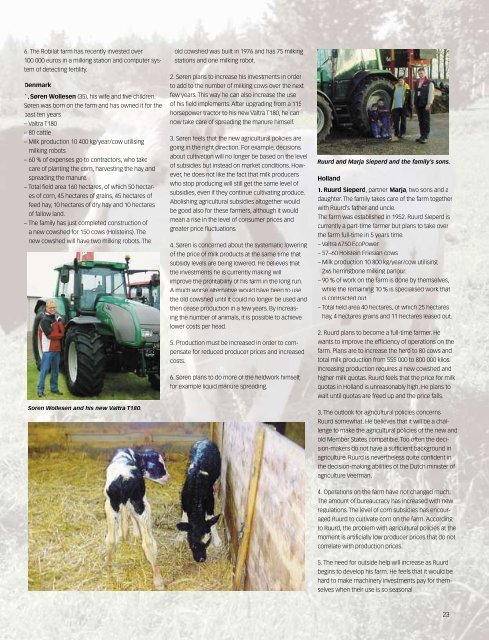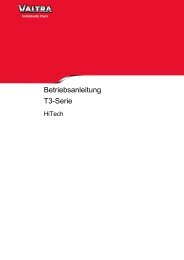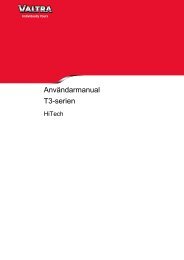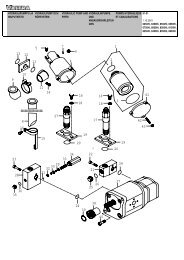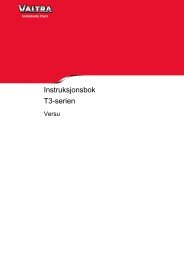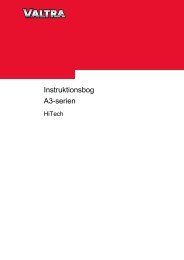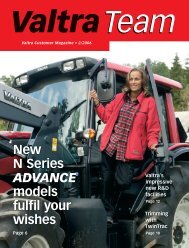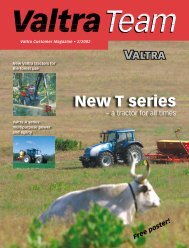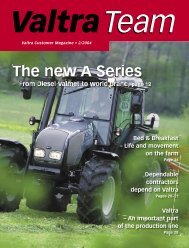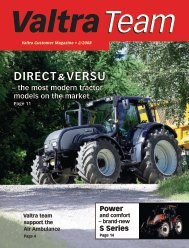New C Series - Valtra
New C Series - Valtra
New C Series - Valtra
- TAGS
- series
- valtra
- www.valtra.com
Create successful ePaper yourself
Turn your PDF publications into a flip-book with our unique Google optimized e-Paper software.
6. The Robilat farm has recently invested over<br />
100 000 euros in a milking station and computer system<br />
of detecting fertility.<br />
Denmark<br />
1. Søren Wollesen (35), his wife and fi ve children.<br />
Søren was born on the farm and has owned it for the<br />
past ten years<br />
– <strong>Valtra</strong> T180<br />
– 80 cattle<br />
– Milk production 10 400 kg/year/cow utilising<br />
milking robots<br />
– 60 % of expenses go to contractors, who take<br />
care of planting the corn, harvesting the hay and<br />
spreading the manure.<br />
– Total fi eld area 160 hectares, of which 50 hectar-<br />
es of corn, 45 hectares of grains, 45 hectares of<br />
feed hay, 10 hectares of dry hay and 10 hectares<br />
of fallow land.<br />
– The family has just completed construction of<br />
a new cowshed for 150 cows (Holsteins). The<br />
new cowshed will have two milking robots. The<br />
Soren Wollesen and his new <strong>Valtra</strong> T180.<br />
old cowshed was built in 1976 and has 75 milking<br />
stations and one milking robot.<br />
2. Søren plans to increase his investments in order<br />
to add to the number of milking cows over the next<br />
few years. This way he can also increase the use<br />
of his fi eld implements. After upgrading from a 115<br />
horsepower tractor to his new <strong>Valtra</strong> T180, he can<br />
now take care of spreading the manure himself.<br />
3. Søren feels that the new agricultural policies are<br />
going in the right direction. For example, decisions<br />
about cultivation will no longer be based on the level<br />
of subsidies but instead on market conditions. However,<br />
he does not like the fact that milk producers<br />
who stop producing will still get the same level of<br />
subsidies, even if they continue cultivating produce.<br />
Abolishing agricultural subsidies altogether would<br />
be good also for these farmers, although it would<br />
mean a rise in the level of consumer prices and<br />
greater price fl uctuations.<br />
4. Søren is concerned about the systematic lowering<br />
of the price of milk products at the same time that<br />
subsidy levels are being lowered. He believes that<br />
the investments he is currently making will<br />
improve the profi tability of his farm in the long run.<br />
A much worse alternative would have been to use<br />
the old cowshed until it could no longer be used and<br />
then cease production in a few years. By increasing<br />
the number of animals, it is possible to achieve<br />
lower costs per head.<br />
5. Production must be increased in order to compensate<br />
for reduced producer prices and increased<br />
costs.<br />
6. Søren plans to do more of the fi eldwork himself,<br />
for example liquid manure spreading.<br />
Ruurd and Marja Sieperd and the family’s sons.<br />
Holland<br />
1. Ruurd Sieperd, partner Marja, two sons and a<br />
daughter. The family takes care of the farm together<br />
with Ruurd’s father and uncle.<br />
The farm was established in 1952. Ruurd Sieperd is<br />
currently a part-time farmer but plans to take over<br />
the farm full-time in 5 years time.<br />
– <strong>Valtra</strong> 6750 EcoPower<br />
– 57–60 Holstein Friesian cows<br />
– Milk production 10 800 kg/year/cow utilising<br />
2x6 herringbone milking parlour.<br />
– 90 % of work on the farm is done by themselves,<br />
while the remaining 10 % is specialised work that<br />
is contracted out.<br />
– Total fi eld area 40 hectares, of which 25 hectares<br />
hay, 4 hectares grains and 11 hectares leased out.<br />
2. Ruurd plans to become a full-time farmer. He<br />
wants to improve the effi ciency of operations on the<br />
farm. Plans are to increase the herd to 80 cows and<br />
total milk production from 555 000 to 800 000 kilos.<br />
Increasing production requires a new cowshed and<br />
higher milk quotas. Ruurd feels that the price for milk<br />
quotas in Holland is unreasonably high. He plans to<br />
wait until quotas are freed up and the price falls.<br />
3. The outlook for agricultural policies concerns<br />
Ruurd somewhat. He believes that it will be a challenge<br />
to make the agricultural policies of the new and<br />
old Member States compatible. Too often the decision-makers<br />
do not have a suffi cient background in<br />
agriculture. Ruurd is nevertheless quite confi dent in<br />
the decision-making abilities of the Dutch minister of<br />
agriculture Veerman.<br />
4. Operations on the farm have not changed much.<br />
The amount of bureaucracy has increased with new<br />
regulations. The level of corn subsidies has encouraged<br />
Ruurd to cultivate corn on the farm. According<br />
to Ruurd, the problem with agricultural policies at the<br />
moment is artifi cially low producer prices that do not<br />
correlate with production prices.<br />
5. The need for outside help will increase as Ruurd<br />
begins to develop his farm. He feels that it would be<br />
hard to make machinery investments pay for themselves<br />
when their use is so seasonal.<br />
23


